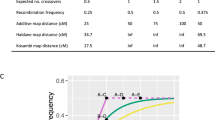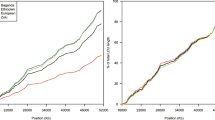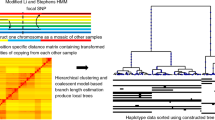Abstract
In 1992, we described a second-generation genetic linkage map of the human genome. Using 1,267 new microsatellite markers, we now present a new genetic linkage map containing a total of 2,066 (AC)n short tandem repeats, 60% of which show a heterozygosity of over 0.7. Statistical linkage analysis based on the genotyping of eight large CEPH families placed these markers in the 23 linkage groups. The map includes 1,266 intervals and spans a total distance of 3690 centiMorgans (cM). A total of 1,041 markers could be ordered with odds ratios greater than 1000:1. About 56% of this map is at a distance of 1 cM or less from one of its markers.
This is a preview of subscription content, access via your institution
Access options
Subscribe to this journal
Receive 12 print issues and online access
$209.00 per year
only $17.42 per issue
Buy this article
- Purchase on Springer Link
- Instant access to full article PDF
Prices may be subject to local taxes which are calculated during checkout
Similar content being viewed by others
References
Litt, M. & Luty, J.A. A hypervariable microsatellite revealed by in vitro amplification of a dinucleotide repeat within the cardiac muscle actin gene. Am. J. hum. Genet. 44, 397–101 (1989).
Weber, J.L. & May, P.E. Abundant class of human DNA polymorphisms which can be typed using the polymerase chain reaction. Am. J. hum. Genet. 44, 388–396 (1989).
Dietrich, W. et al. A genetic map of the mouse suitable for typing intraspecific crosses. Genetics 131, 423–447 (1992).
Weissenbach, J. et al. A second-generation linkage map of the human genome. Nature 359, 794–801 (1992).
Serikawa, T. et al. Rat gene mapping using PCR-analyzed microsatellites. Genetics 131, 701–721 (1992).
Bernardi, G. The isochore organization of the human genome and its evolutionary history — a review. Gene 135, 57–66 (1993).
Vignal, A. et al. A non-radioactive multiplex procedure for genotyping of microsatellite markers. In Methods in Molecular Genetics: Gene and Chromosome Analysis (ed. Adolph, K. W.) 211–221 (Academic Press, San-Diego, 1993).
Weber, J.L. & Wong, C. Mutation of human short tandem repeats. Hum. molec. Genet. 2, 1123–1128 (1993).
Matise, T.C., Perlin, M. & Chakravarti, A. Automated construction of genetic linkage maps using an expert system (MultiMap): a human genome linkage map. Nature Genet. 6, 384–390 (1994).
Lander, E.S. & Green, P. Construction of multilocus genetic linkage maps in humans. Proc. natn. Acad. Sci. U.S.A. 84, 2363–2367 (1987).
Lathrop, M. et al. A primary genetic map of markers of human chromosome 10. Genomics 2, 157–164 (1988).
Saccone, S., De Sario, A., Delia Valle, G. & Bernardi, G. The highest gene concentrations in the human genome are in T-bands of metaphase chromosomes. Proc. natn. Acad. Sci. U.S.A. 89, 4913–4917 (1992).
Buetow, K.H. et al. Integrated human genome-wide maps constructed using the CEPH reference panel. Nature Genet. 6, 391–393 (1994).
Cohen, D., Chumakov, I. & Weissenbach, J. A first-generation physical map of the human genome. Nature 366, 698–701 (1993).
Lathrop, G.M. & Lalouel, J.M. Easy calculations of lod scores and genetic risks on small computers. Am. J. hum. Genet. 36, 460–465 (1984).
Lathrop, G.M. & Lalouel, J.M. Statistical methods for linkage analysis. In Handbook of Statistics (ed. Chakraborty, C.) 81–123 (Elsevier, Amsterdam, 1991).
Hudson, T.J. et al. Isolation and chromosomal assignment of 100 highly informative human simple sequence repeat polymorphisms. Genomics 13, 622–629 (1992).
Barber, T.D. et al. A highly informative dinucleotide repeat polymorphism at the D2S211 locus linked to ALPP, FN1 and TNP1. Hum. molec. Genet. 2, 88 (1993).
Cassard, A.M. et al. Human uncoupling protein gene: structure, comparison with rat gene, and assignment to the long arm of chromosome 4. J. Cell. Biochem. 43, 255–264 (1990).
Goold, R.D. et al. The development of Sequence-Tagged sites for human chromosome 4. Hum. molec. Genet. 2, 1271–1288 (1993).
Bosma, P.J. et al. Human plasminogen activator inhibitor-1 gene: Promoter and structural gene nucleotide sequences. J. biol. Chem. 263, 9129–9141 (1988).
Wilkie, P.J., Krizman, D.B. & Weber, J.L. Linkage map of human chromosome 9 microsatellite polymorphisms. Genomics 12, 607–609 (1992).
Litt, M., Sharma, V. & Luty, J.A. A highly polymorphic (TG)n microsatellite at the D11S35 locus. Cytogenet. Cell Genet. 51, 1034 (1989).
Reed, K.E. et al. Molecular cloning and functional expression of human connexin37, an endothelial cell gap junction protein. J. clin Invest. 91, 997–1004 (1993).
Bowcock, A. et al. Microsatellite polymorphism linkage map of human chromosome 13q. Genomics 15, 376–386 (1993).
Polymeropoulos, M.H., Xiao, H., Ide, S.E. & Merril, C.R. Dinucleotide repeat polymorphism at the D14S99E locus. Hum. molec. Genet. 2, 490 (1993).
Shen, Y. et al. Four dinucleotide repeat polymorphisms on human chromosome 16 at D16S289, D16S318, D16S319 and D16S320. Hum. molec. Genet. 1, 773 (1992).
Sharma, V., Quo, Z. & Litt, M. Dinucleotide repeat polymorphism at the D18S37 locus. Hum. molec. Genet. 1, 289 (1992).
Brophy, B.K. et al. cDNA sequence of the pregnancy-specific β1-glycoprotein-11s (PSG-11s). Biochim. Biophys. Acta 1131, 119–121 (1992).
Thompson, L.H. et al. Molecular cloning of thee human XRCC1 gene, which corrects defective DNA strand break repair and sister chromatid exchange. Molec. Cell Biol. 10, 6160–6171 (1990).
Martin-Gallardo, A. et al. Automated DNA sequencing and analysis of 106 kilobasesfrom human chromosome 19q13.3. Nature Genet. 1, 34–39 (1992).
Lindsay, S.J. et al. Isolation and characterisation of highly polymorphic markers and retinal cDNAs in the vicinities of X-linked inherited eye disease loci. Cytogenet. Cell Genet. 58, 2075 (1991).
Author information
Authors and Affiliations
Rights and permissions
About this article
Cite this article
Gyapay, G., Morissette, J., Vignal, A. et al. The 1993–94 Généthon human genetic linkage map. Nat Genet 7 (Suppl 2), 246–339 (1994). https://doi.org/10.1038/ng0694supp-246
Issue Date:
DOI: https://doi.org/10.1038/ng0694supp-246
This article is cited by
-
Phenotype, genotype, and management of congenital fibrosis of extraocular muscles type 1 in 16 Chinese families
Graefe's Archive for Clinical and Experimental Ophthalmology (2023)
-
Machado-Joseph disease in a Sudanese family links East Africa to Portuguese families and allows reestimation of ancestral age of the Machado lineage
Human Genetics (2023)
-
Locus specific engineering of tandem DNA repeats in the genome of Saccharomyces cerevisiae using CRISPR/Cas9 and overlapping oligonucleotides
Scientific Reports (2018)
-
The Bermuda Triangle: The Pragmatics, Policies, and Principles for Data Sharing in the History of the Human Genome Project
Journal of the History of Biology (2018)
-
Partial tetrasomy of the proximal long arm of chromosome 15 in two patients: the significance of the gene dosage in terms of phenotype
Molecular Cytogenetics (2015)



